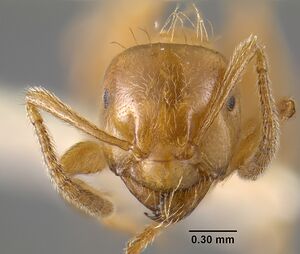Lasius colei
| Lasius colei | |
|---|---|

| |
| Scientific classification | |
| Kingdom: | Animalia |
| Phylum: | Arthropoda |
| Class: | Insecta |
| Order: | Hymenoptera |
| Family: | Formicidae |
| Subfamily: | Formicinae |
| Tribe: | Lasiini |
| Genus: | Lasius |
| Section: | flavus clade |
| Species group: | claviger |
| Species: | L. colei |
| Binomial name | |
| Lasius colei (Wing, 1968) | |
Cole discovered colonies under stones on moist pine slopes.
Identification
Erect hairs on the dorsum of the gaster are 0.23 mm or more in length and those on the underside of the head are 0.20 mm or greater in length. Most of the hairs on the dorsum of the gaster are found near the posterior edges of each tergum, although there are a few hairs scattered over the surface. The pubescence on the head is sparse, and the mandibles rarely have a denticle on the basal margin. (Mackay and Mackay 2002)
Keys including this Species
- Key to Lasius-Nearctic Acanthomyops males
- Key to Lasius-Nearctic Acanthomyops workers
- Key to North American Lasius Species
Distribution
Southern Arizona and southern New Mexico.
Latitudinal Distribution Pattern
Latitudinal Range: 34.156971° to 31.919251°.
| North Temperate |
North Subtropical |
Tropical | South Subtropical |
South Temperate |
- Source: AntMaps
Distribution based on Regional Taxon Lists
Nearctic Region: United States (type locality).
Distribution based on AntMaps
Distribution based on AntWeb specimens
Check data from AntWeb
Countries Occupied
| Number of countries occupied by this species based on AntWiki Regional Taxon Lists. In general, fewer countries occupied indicates a narrower range, while more countries indicates a more widespread species. |

|
Estimated Abundance
| Relative abundance based on number of AntMaps records per species (this species within the purple bar). Fewer records (to the left) indicates a less abundant/encountered species while more records (to the right) indicates more abundant/encountered species. |

|
Biology
Castes
Worker
   
| |
| . | Owned by Museum of Comparative Zoology. |
Nomenclature
The following information is derived from Barry Bolton's Online Catalogue of the Ants of the World.
- colei. Acanthomyops colei Wing, 1968: 88, figs. 64-67 (w.m.) U.S.A. Combination in Lasius: Ward, 2005: 13.
Unless otherwise noted the text for the remainder of this section is reported from the publication that includes the original description.
Description
Worker
Somewhat similar to small Lasius interjectus; closely related to Lasius californicus, but SI 86-90. Petiolar scale with crest straight to weakly emarginate; sides straight and strongly converging dorsally, sometimes slightly convex. Standing body hairs finely to strongly barbulate, ranging and averaging longer than in californicus. Gula with 4 to 6 standing hairs, clypeus with 6 to 8. Alitrunk with most standing hairs flexed. Standing hairs on gaster fewer than on californicus, with somewhat irregular distribution, but mostly concentrated on or near posterior edges of tergites. Pubescence on scapes loosely appressed to strongly suberect.
Pubescence dilute, body shining. Color yellowish brown to brown.
Male
Similar to californicus. Crest of petiolar scale sharp to very sharp, strongly to weakly emarginate; sides straight and converging dorsally, sometimes convex. Length of longer hairs on crest and sides of scale and on clypeus 0.18 mm or more, many flexed, those on posterior tip of gaster 0.27 mm or more. Standing body hairs weakly to strongly barbulate, a few, especially on alitrunk, with conspicuous bifurcate tips. Cula with 4 standing hairs. Pubescence on head dilute, that on dorsum of gaster very dilute.
Body light brown, head darker.
Type Material
Type locality: Cochise Stronghold, Dragoon Mts., Cochise Co., Arizona.
Location of types: Holotype worker and 3 paratype workers in the Museum of Comparative Zoology, 2 paratypes in the National Museum of Natural History, 2 paratypes in the Cornell collection, and 10 paratypes in the collection of A. C. Cole.
Etymology
This species is named for Dr. A. C. Cole, University of Tennessee. He is the only collector other than W. M. Wheeler who has taken this species.
References
- Mackay, W. P. and E. Mackay. 2002. The ants of New Mexico (Hymenoptera: Formicidae). Edwin Mellen Press, Lewiston, NY.
- Ward, P.S. 2005. A synoptic review of the ants of California (Hymenoptera: Formicidae). Zootaxa 936: 1-68 (page 13, new combination in Lasius (Acanthomyops))
- Wing, M. W. 1968a. Taxonomic revision of the Nearctic genus Acanthomyops (Hymenoptera: Formicidae). Mem. Cornell Univ. Agric. Exp. Stn. 405: 1-173 (page 88, figs. 64-67 worker, male described)
References based on Global Ant Biodiversity Informatics
- Johnson R. Personnal Database. Accessed on February 5th 2014 at http://www.asu.edu/clas/sirgtools/resources.htm
- Mackay W. P., and E. E. Mackay. 2002. The ants of New Mexico (Hymenoptera: Formicidae). Lewiston, New York: Edwin Mellen Press, 400 pp.
- Wing M. W. 1968. Taxonomic revision of the Nearctic genus Acanthomyops (Hymenoptera: Formicidae). Memoirs of the Cornell University Agricultural Experiment Station 405: 1-173.


